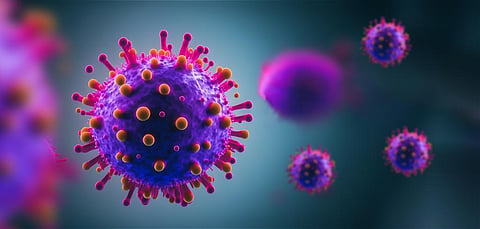The ‘kraken’ COVID variant XBB.1.5 is rising quickly in the US — here’s what it could mean for the UK
The heavily-mutated omicron variant of SARS-CoV-2, the virus that causes COVID-19, was first detected in late 2021.
Due to the many mutations in the spike protein (a protein on the surface of SARS-CoV-2 that allows the virus to attach to our cells) omicron was able to quickly become the dominant SARS-CoV-2 variant. These mutations allowed it to bind to respiratory cells more tightly than previous variants, rendering it more infectious.
Owing to the dominance of omicron, thanks to these mutations, the past several months have seen the emergence of many subvariants of omicron (scientists have identified more than 650 to date).
The latest variant to worry health professionals and virologists alike is XBB.1.5, nicknamed “kraken” by a group of scientists that has been naming new variants after mythological creatures to make the virus’ evolution more accessible to the public. Here’s what we know about it.
XBB.1.5 is a derivative of the XBB variant of omicron. XBB was never designated as a variant of concern by the World Health Organization because data shows that, while XBB’s mutations enable it to evade our immune systems better than previous omicron subvariants, it doesn’t appear to be causing an increase in infection rates.
In addition to the mutations that XBB.1 has, XBB.1.5 also carries a mutation called S486P in the spike protein region. Preliminary laboratory studies, yet to be peer-reviewed, have shown that, similar to XBB.1, XBB.1.5 is less sensitive to antibodies acquired from vaccination than previous variants XBB and BQ1.1. So it’s very good at evading our immune response.
The same preprint showed that XBB.1.5 was able to bind to ACE2 (the receptor the virus uses to infect our cells) more strongly than these earlier variants. This is the characteristic that made the original omicron variant so infectious and so dominant.
Having first been detected in October 2022 in the US, XBB.1.5 has spread rapidly in the country and is now responsible for around 28 per cent of all new infections. Elsewhere, XBB.1.5 has been detected in at least 23 countries, including the UK. But according to the most recent data, it accounts for only 4 per cent of COVID infections in England.
Given what we’re seeing in the US, it’s likely that XBB.1.5 will become the dominant strain in the UK and Europe in time. But as there are always differences in populations (for example, vaccination rates and social behaviour) it’s hard to predict exactly how things will play out.
So should we be worried?
Though some of XBB.1.5’s characteristics are concerning, the real-world infection data is not showing an overall increase in infections or deaths globally or in the US (where XBB.1.5. is rife) at present.
It’s too early to tell whether infections from XBB.1.5 are more severe than previous variants, however experts agree that there is no evidence at this stage that it poses any higher risk than variants that have come before it.
Experts also agree that vaccination will continue to protect against serious disease and death from XBB.1.5.
With a new variant, there’s always the risk it will affect clinically vulnerable people more severely. Older people and those with conditions that affect their immune systems mount weaker responses to COVID vaccines, so are less protected than the “healthy” population. This means variants that spread more easily or can better evade our immune system may be more likely to infect these people if they’re exposed.
So, while COVID continues to circulate, it’s best to take extra precautions when meeting vulnerable people such as wearing a mask, washing your hands thoroughly, ventilating the space that you are in (or even meeting outdoors), and not meeting them at all if you are ill.
Grace C Roberts, Research Fellow in Virology, University of Leeds
This article is republished from The Conversation under a Creative Commons license. Read the original article.

